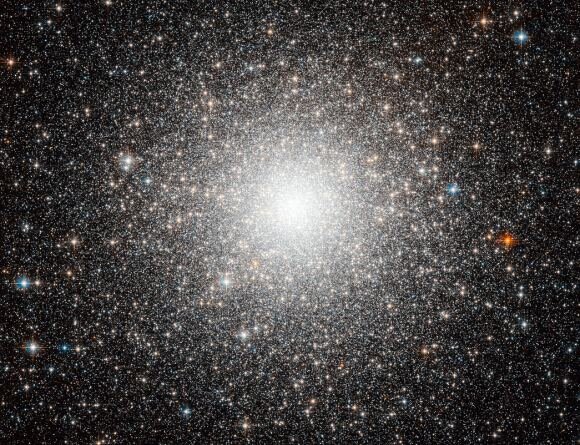The globular cluster Messier 54. Credit: NASA
A team of astronomers studied two nearby globular clusters, 47 Tucanae and Omega Centauri, searching for signals produced by annihilating dark matter. Though the searches turned up empty, they weren’t a failure. The lack of a detection placed strict upper limits on the mass of the hypothetical dark matter particle.
Shining a light on dark matter
Dark matter makes up around 80% of all the mass in the universe, although it’s completely invisible. It simply doesn’t interact with the electromagnetic force, and so it doesn’t glow or reflect or absorb or anything. So far, the only evidence we have for its existence is through its gravitational effects on the rest of the universe. Because of this, astronomers aren’t exactly sure about what dark matter is, although many physicists believe that it’s some new kind of particle, previously unknown to the standard model of particle physics.
One possibility is that dark matter is made of some ultra-light particle, like an axion. And while these particles wouldn’t interact with normal matter, they might very rarely interact with themselves, colliding together and annihilating. If the energy of the collision is high enough, it can result in the production of a gamma ray, which then splits off to become an electron and positron.
Those electrons and positrons can glue together to form bound states, called positronium. However, the positronium atoms aren’t stable, and they eventually decay, leaving behind a flash of radio emission.
So even though dark matter doesn’t interact with electromagnetism directly, there’s still the possibility of us seeing the radio emission from the collision and decay of dark matter particles.
Look to the globular clusters
To make this work you need a lot of dark matter. If the dark matter particles collided easily enough, we would’ve seen it already. So the collisions must be rare. The density of dark matter in our galactic neighborhood is far too low to make detectable emission, but the dense cores of galaxies may offer better access.
The natural place to look is our galactic core, but that place is swamped with all kinds of radio emission, so it’s difficult to tell if a particular signal is coming from annihilating dark matter or something more mundane. So that’s why a team of astronomers looked to two nearby globular clusters, as reported in a paper recently appearing in the preprint journal arXiv.
The two clusters, 47 Tucanae and Omega Centauri, are only a few thousand light-years away, making them relatively easy to observe. And astronomers believe that they are the remnants of dwarf galaxies, the bulk of their stars stripped away from them through interactions with the Milky Way.
This makes the clusters ideal laboratories, because they are essentially balls of dense dark matter with very little contamination. The team of astronomers went looking for the unique radio signal of decaying positronium using the Parkes observatory in Australia.
They didn’t find anything, which isn’t necessarily a bad thing. Based on their observations, they were able to place the best upper limits yet on the mass and cross-section (a measure of how frequently the particles interact) of these light dark matter models. Sure, it would have been awesome to see a confirmed signal and finally put this dark matter mystery to rest, but new knowledge in any direction is always welcome and always helpful.
New theory suggests collision of dwarf galaxies could explain dark matter–free galaxies More information: Lister Staveley-Smith, Emma Bond, Kenji Bekki, Tobias Westmeier, A Search for Annihilating Dark Matter in 47 Tucanae and Omega Centauri. arXiv:2205.01270v3 [astro-ph.HE], arxiv.org/abs/2205.01270 Provided by Universe Today
Citation: Could we detect dark matter’s annihilation within globular clusters? (2022, June 1) retrieved 4 June 2022 from https://phys.org/news/2022-06-dark-annihilation-globular-clusters.html
This document is subject to copyright. Apart from any fair dealing for the purpose of private study or research, no part may be reproduced without the written permission. The content is provided for information purposes only.
































